Phil Garton, Danial Gaudry, and Rhett Wilcox1
The Australian dollar has appreciated strongly over the past decade, leading to increased concerns over the impacts of the high exchange rate on trade-exposed sectors of the economy. This paper examines the underlying drivers of this rise, the exchange rate’s role as a macroeconomic shock absorber and the implications of various policy options that might be directed at reducing the exchange rate.
Introduction
Over the past decade, the Australian dollar (AUD) has appreciated strongly against the US dollar (USD), rising from less than US $0.50 in 2001 to a peak of over US $1.10 in 2011. While the rise can be attributed to a number of factors, the mining boom has been the key driver of the appreciation over this period.
The AUD has remained well above its post-float average for a number of years, and has generally been around or above parity against the USD since October 2010, when it reached parity for the first time since it was floated in December 1983. The prolonged high level of the currency has led to significant debate regarding its effects on the Australian economy. Indeed, there have been calls for Australia to reconsider the long-standing policy of allowing the AUD to float relatively freely.
Against this backdrop, this paper examines the factors determining the value of the AUD and its role in the macroeconomy more broadly. It also discusses the implications of various policy options that might be directed at reducing the exchange rate.
Measuring the exchange rate
The value of the AUD is generally reported as a nominal bilateral rate, which is the rate at which one unit of currency can be exchanged for another. Given that the USD is a global major currency, the AUD/USD cross rate receives the most attention.
An alternative measure is an effective exchange rate, which is a trade-weighted average of bilateral exchange rates. Generally this provides a more informative measure of the value of the AUD, particularly when bilateral exchange rates exhibit diverging trends (RBA 2002). A commonly-cited measure is the trade-weighted index (TWI) published by the Reserve Bank of Australia (RBA), which weights the currencies of Australia’s largest trading partners by their shares of Australia’s trade.
Both the TWI and the USD exchange rates are important measures. The TWI provides a more accurate reflection of overall trade competitiveness as it includes the exchange rates of all our major trading partners. The USD exchange rate is also important as a significant proportion of Australia’s trade is denominated in USDs, even if the United States is not a direct participant in the transaction.
Another measure of the exchange rate is the real effective exchange rate, which is the trade-weighted nominal exchange rate multiplied by the ratio of Australian prices to our trading partners’ price levels. Since trade competitiveness is ultimately determined by changes in the relative price of Australian goods and services in terms of foreign goods and services, the real exchange rate is conceptually a better measure of trade competitiveness.
A commonly used measure of the real effective exchange rate is the RBA’s real TWI, which uses the core consumer price index (CPI) measure of price levels (which excludes food and energy).
There are also alternative weighting schemes. Movements in trade-weighted measures such as the real TWI provide only a rough measure of changes in Australia’s trade competitiveness, since weights based on trade shares do not capture changes in prices relative to countries that are competing suppliers to our exports in third countries (Ellis 2001).
The economic role of the exchange rate
In an open economy, the exchange rate is a key economy-wide relative price that helps to maintain equilibrium across both the financial and real sides of the economy. The exchange rate — along with other variables such as interest rates, output and prices — adjusts to simultaneously equate demand and supply in the foreign exchange market, other financial markets, and goods and services markets.
Most importantly, movements in the nominal exchange rate play a critical role in allowing the real economy to adjust to shocks while limiting the impacts on macroeconomic stability. As the currency normally appreciates (depreciates) in response to shocks that have a stimulatory (contractionary) impact on the economy, the exchange rate functions as an automatic stabiliser that helps keep the economy growing at a rate consistent with its non-inflationary level of capacity utilisation (full employment).
For instance, a shock that boosts demand for Australian goods requires domestic prices to rise relative to foreign prices (that is, a real exchange rate appreciation) unless there is substantial spare capacity in the economy.2 This brings demand and supply into line by shifting spending from domestic to foreign goods and by promoting increased supply of domestic goods. Similarly, a shock that reduces demand for Australian goods will require a real depreciation.
Under a flexible exchange rate regime, where monetary policy targets low inflation, these relative price movements occur mainly through the nominal exchange rate. This is closely linked to the operation of monetary policy, as the exchange rate tends to appreciate (depreciate) when domestic interest rates rise (fall) relative to foreign interest rates. When the economy is strong (weak), monetary policy will be tighter (easier) than normal and the exchange rate will generally rise above (fall below) its medium-term level.
If the nominal exchange rate is prevented from moving, the required real appreciation (depreciation) will instead occur through domestic prices and wages rising (falling) relative to foreign prices and wages. While exchange rate volatility can be costly, it is less costly for relative price adjustments to occur through the nominal exchange rate, for two main reasons.
- First, higher inflation has economic costs. Greater uncertainty about future prices hampers longer-term decision-making and leads to higher real interest rates as lenders demand a premium for inflation risk. As interest income is taxed on a nominal basis, higher inflation also discourages saving by considerably reducing the real after-tax rate of return.
- Second, real depreciation through price and wage deflation can normally be achieved only through an extended period of economic weakness and high unemployment. This problem is illustrated by the severe recessions currently being experienced in the peripheral economies within the euro area, which cannot achieve the real depreciation they need through the nominal exchange rate.
Chart 1 confirms that the floating exchange rate has served as an automatic stabiliser for the Australian economy. The AUD has generally been high (low) relative to trend when domestic demand (gross national expenditure) has been relatively strong (weak). These cyclical variations suggest that it may be desirable for the exchange rate to be above or below its medium-term equilibrium at any time.3
Chart 1: Real gross national expenditure and exchange rate divergences from trend
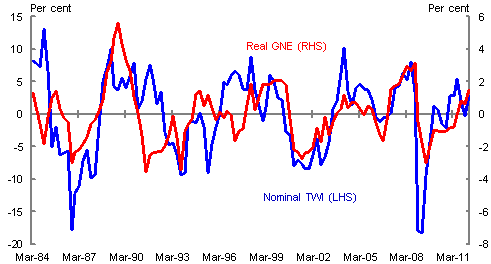
Note: Trend is based on a Hodrick-Prescott filter.
Source: ABS cat. no. 5206.0, RBA and Treasury.
Recent trends in the AUD
Over the past decade the AUD has been on an upward trend against both the USD and the TWI (Chart 2), with the notable exception of the global financial crisis (GFC) period when it
fell sharply from June 2008 to November 2008. Since its recent trough in June 2010, the AUD has appreciated by around 21 per cent against the USD and by around 14 per cent against the TWI. To put these figures into perspective, the AUD is now around 33 per cent above its post-float average of 75 US cents and around 24 per cent above its post-float average of 60 against the TWI (as at 24 July).
Chart 2: AUD against the USD and the TWI
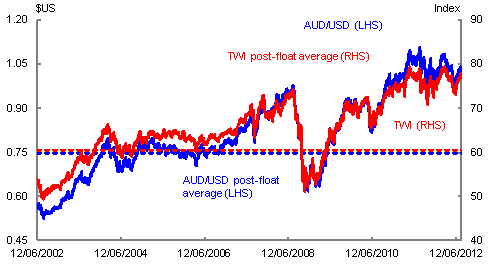
Source: RBA and Treasury
Since the current terms of trade boom began around 2004, the increase in the real TWI has been even more pronounced than the increase in the nominal TWI (Chart 3). This reflects higher average core inflation in Australia over the past decade than in our major trading partners, largely as a result of unusually low inflation in the rest of the world.
Chart 3: Real and nominal TWIs and the terms of trade
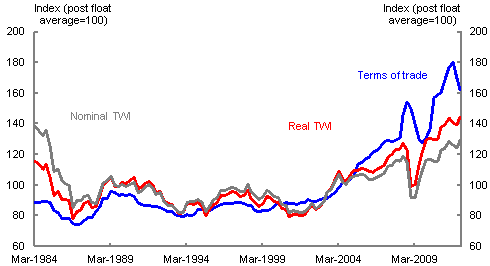
Source: RBA
Why is the Australian dollar so high at present?
High terms of trade
The primary reason why the AUD has appreciated so much since the early 2000s is that Australia’s terms of trade have doubled over this period, mainly due to rises in world prices for our commodity exports.
From a real economy perspective, a rise in commodity export prices raises the equilibrium real exchange rate because it leads to increased demand for Australian goods, requiring their price to rise relative to foreign goods.4 This normally occurs for two reasons:
- higher commodity prices lead to increased investment to expand capacity in the resources sector; and
- higher aggregate incomes resulting from the rise in the terms of trade lead to an increase in consumption spending, much of which is on domestic goods.
The higher exchange rate is promoting the reallocation of labour and capital to meet these demands by reducing returns in other tradable sectors. If this adjustment did not occur through a higher nominal exchange rate, it would instead occur through higher domestic prices. This is what occurred during the terms of trade boom of the early 1970s, when Australia had a fixed exchange rate and governments were reluctant to revalue the currency (Gruen 2011). This means that the rise in the real exchange rate would still occur over time through higher inflation, even if the nominal exchange rate was held down.
It is true that growth in domestic demand has been more subdued since the GFC than in the initial phase of the terms of trade boom, reflecting in part a more cautious approach to spending by households. Nonetheless, the level of demand remains considerably higher than it would have been had the rise in the terms of trade not occurred. This means that the level of the real exchange rate also needs to be higher.
This can be seen in Chart 5, which shows the cumulative gap between growth in real gross national income and expenditure and cumulative growth in real GDP since the end of 2002. These gaps provide measures of the income gain from the terms of trade and the extent to which it has fed into increased spending (with a constant terms of trade, real national income would have grown in line with real GDP).
Chart 4: Cumulative excess growth in real income and expenditure
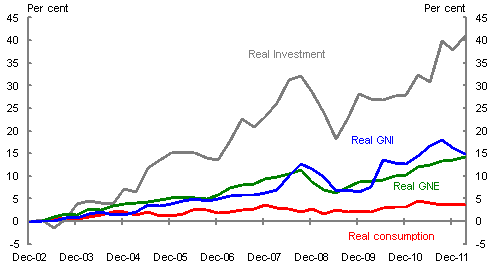
Note: Real GNE is the sum of private and public consumption and investment. The chart shows the cumulative growth of the described variables in excess of the growth in real GDP.
Source: ABS cat. no. 5206.0 and Treasury.
Real national income has grown by 15 percentage points more than real GDP over this period, while real national expenditure has grown 14 percentage points more. This is due largely to very strong growth in investment, though consumption has also grown about 4 percentage points faster than real GDP.
The appreciation in the AUD is also in line with what one would expect from the point of view of the other markets in which the exchange rate plays an important role. From a financial market perspective, a rise in resource prices raises the equilibrium exchange rate for two reasons:
- the rate of return on capital invested in the resources sector rises; and
- the stimulus to domestic demand from higher incomes may require tighter monetary policy than otherwise, resulting in higher interest rates.
From a foreign exchange market perspective, a rise in the prices of commodity exports increases demand for AUDs through both increased export receipts and increased capital inflows in response to higher returns on Australian assets.
Economic weakness and increased risk in other advanced economies
While the terms of trade have been the main driver of the rise in the AUD since the early 2000s, circumstances in other advanced economies have also contributed to the strong AUD since the GFC.
Firstly, a prolonged period of economic weakness has seen interest rates in the major advanced economies remain at abnormally low levels. As a result, the differential between Australian interest rates and those in other advanced economies has been unusually high, even though Australian interest rates have not themselves been unusually high. In addition to holding policy interest rates at or near the zero lower bound, some central banks have also undertaken monetary expansion through quantitative easing, which also puts downward pressure on their currencies, thereby contributing to the high AUD.
Secondly, a number of other advanced economies are now judged to be more risky on account of high levels of government debt, weak economic growth and fragile banking systems. In contrast, Australia is now one of only seven countries whose national government debt is still rated AAA with a stable outlook by all three major credit rating agencies.
The combination of these factors has increased risk-adjusted returns on Australian assets in relative terms, boosting global investors’ demand for AUD assets.
Estimates of equilibrium exchange rates
The competitive pressures placed on certain sectors by the high real exchange rate are reflected in concerns that the AUD might be overvalued. This would imply not only that the exchange rate is elevated, but also that it is above a level warranted by its fundamental determinants; that is, the equilibrium exchange rate.
Determining this equilibrium exchange rate, however, has long been a contentious issue in applied economics, reflecting the difficulties of modelling all the relevant economic linkages that determine the exchange rate. Notwithstanding this, substantial efforts have been made to analyse the issue. The IMF, for example, does so through the Consultative Group on Exchange Rate issues (CGER), which provides exchange rate assessments for use in its Article IV staff reports (IMF 2006).
While there are many methods for deriving medium-to-long-run equilibrium exchange rates, the simplest is to calculate the nominal exchange rate that would equalise prices in Australia and its trading partners, expressed in a common currency. Indeed, a number of analysts use this condition, which is based on the theory of purchasing power parity (PPP), as a rule of thumb guide to whether a nominal exchange rate is too strong or weak.For example, Bloomberg and the OECD publish formal PPP exchange rates, while The Economist publishes its Big Mac Index.
There are, however, many reasons to question the
validity of PPP-based estimates (Box 1). More sophisticated analyses generally take a macroeconomic approach to estimating a medium or long-run equilibrium exchange rate, taking into account the factors discussed earlier in this paper (Wren-Lewis 2003). The more commonly used approaches attempt to estimate the fundamental equilibrium exchange rates — the exchange rate consistent with macroeconomic equilibrium — or reduced form equations. For example, in the former vein the IMF uses the ‘macroeconomic balance’ and the ‘external sustainability’ approaches, and for the latter, the ‘equilibrium real exchange rate’ approach (IMF 2006).
Both the macroeconomic balance and external sustainability approaches involve making an assessment of current account ‘norms’ — albeit using different methods — and the real exchange rate adjustment required to close the gap between this and the projected underlying current account with economies operating at full capacity. The third approach derives the equilibrium exchange rate by estimating a long-run relationship between the exchange rate and a set of relevant fundamentals.
Notwithstanding the differences in these approaches, including the measure of the exchange rate and the date at which the estimations were performed, comparing the equilibrium values they produce with the prevailing exchange rate suggests, unsurprisingly, that the AUD is overvalued compared to its medium-to-long run equilibrium value (Table 1).
These estimates are, however, subject to considerable uncertainty. For example, while the IMF estimates that Australia’s real exchange rate is overvalued, the 90 per cent confidence intervals around the estimates are large — so much so that the estimated overvaluation is not statistically significant using the macroeconomic balance approach.5 Aside from estimation uncertainty, it is important to note that the IMF’s estimates are based on medium-to-long term concepts of equilibrium, which do take into account cyclical divergences in economic activity and relative interest rates.
| Institution | Date | Measure | Method | Overvaluation (%) |
|---|---|---|---|---|
| Bllomberg | Jun-12 | AUD/USD | PPP (consumer prices) | 30.12 |
| Jun-12 | AUD/USD | PPP (producer prices) | 27.87 | |
| OECD | Jun-12 | AUD/USD | PPP | 35.41 |
| IMF- | Oct-11 | REER | Macroeconomic Balance | 11 |
| Article IV | External Sustainability | 19.4 | ||
| Equilibrium real exchange rate | 16.4 |
Note: Bloomberg and OECD estimates use exchange rates as of 14 June 2012.
Source: Bloomberg and IMF.
Nominal exchange rates frequently diverge from estimates of fair value in the short run. This reflects the fact that short-run movements in the exchange rate may be driven by changes in the desire of foreign investors to hold Australian assets, in response to factors such as prevailing interest rate differentials and perceptions of risk. Cyclical variations in monetary policy also influence these movements. As noted above, these short-term movements in the exchange rate help to equilibrate financial markets and are also a key channel through which monetary policy operates.
Estimates of equilibrium exchange rates over the medium-to-longer term abstract from these cyclical influences, on the basis that they do not affect its level over the longer term, which is determined by factors such as Australia’s foreign asset position and the terms of trade. This point is widely misunderstood, with a common assertion being that if the real exchange rate is above its medium-term equilibrium, this must imply that it is currently inappropriately high.
Thus, while estimates suggesting that the real exchange rate is above its medium-to-long term equilibrium may provide information about the likely direction of the exchange rate over an extended period of time, they need not imply that its current level is undesirably high, nor that intervention is warranted.
Box 1: Purchasing power parity
One of the best-known and tested theories for determining the long-run equilibrium exchange rate is purchasing power parity (PPP). PPP suggests that prices should be equal across countries when measured in a common currency.6 If so, the real exchange rate should be a ‘stationary’ time series.
While a number of analysts use PPP as a rule of thumb guide to whether a nominal exchange rate is too strong or weak, there are various reasons to question its validity as a benchmark. For instance, traded goods (particularly complex manufactures) are often imperfect substitutes and many goods and services are not traded. This implies that there is little reason to expect price levels to converge across countries. Indeed, numerous studies find that the real exchange rate does not appear to be stationary but is ‘non-stationary’.7
The finding that the real exchange rate is non-stationary is important, since it implies that its high level alone need not suggest that it is overvalued and will fall back to some ‘normal’ value in the future. Instead, future movements in the exchange rate depend on the factors that explain its current level and the extent to which these influences will be sustained over time.
Even if prices of tradable goods were equalised — and the empirical evidence on this is ambiguous — persistent deviations in the real exchange rate from PPP would still occur due to differences in prices of non tradables between countries. Key factors that may cause prices of non tradables to diverge include variations in the terms of trade and differences in productivity levels and growth rates.
For example, the Balassa Samuelson effect suggests that, under certain conditions, productivity growth that is faster in the tradable sector than the non tradable sector should, by boosting wages across the economy, lead to an increase in the price of non tradables in terms of tradables. If this productivity bias is stronger domestically than abroad then the real exchange rate should appreciate.
Why can’t something be done to lower the exchange rate?
Concerns about the negative impacts of a high exchange rate have led some commentators to argue that Australia should stop allowing the exchange rate to float freely and take action to depreciate it or, alternatively, that the monetary policy framework should be changed to focus less on inflation-targeting. In particular, calls have been made for the RBA to follow the example of the Swiss National Bank, which set a cap on the Swiss franc in September 2011 (Box 2).
In considering these arguments, there are two key points to bear in mind:
- First, the exchange rate should be considered from the perspective of overall macroeconomic balance, not from the perspective of particular sectors. Hence, the exchange rate could be considered too high only if it was having an excessive dampening impact on economic activity, causing economic activity to fall below the non-inflationary sustainable level.
- Second, as the exchange rate is closely linked to monetary policy, the two cannot be considered separately. Any attempt to influence the exchange rate must have implications for monetary policy.
Monetary policy
As noted, the ex
change rate will tend to appreciate (depreciate) if domestic interest rates rise (fall) relative to foreign interest rates. This makes the exchange rate one of the key channels through which monetary policy operates. Currency appreciation reinforces the impact of a rise in interest rates on economic activity, while also directly reducing import prices.
This linkage between monetary policy and the exchange rate gives rise to the so-called ‘impossible trinity’. In a country open to capital flows, it is impossible to target the exchange rate while also maintaining an independent monetary policy that targets domestic inflation (and macroeconomic stability more broadly).
For example, if policymakers wished to target a lower exchange rate, the most direct and effective way to do so would be for the RBA to ease monetary policy. If the policy interest rate was initially set at a level consistent with the inflation target, a sustained easing would result in future inflation exceeding the target. But responding to higher inflation would be incompatible with holding down the exchange rate. Hence, the only way to sustain a lower nominal exchange rate would be to shift monetary policy away from targeting inflation to targeting the exchange rate.
If fundamentals such as the terms of trade were driving the nominal appreciation, this would result in the real appreciation occurring instead through higher inflation relative to our trading partners. Real appreciation through higher inflation would occur more slowly, as prices and wages tend to be sticky, but would also be more costly for the economy, especially in the process of again reducing the inflation rate.
While it is possible for the currency to appreciate further than is desirable from a macroeconomic perspective, this has not in large part been the case over the period since 2003-04. Apart from the period following the GFC in 2008-09, when the Australian dollar depreciated sharply, Australia has had a low and/or falling unemployment rate over this period. In the year or two before the GFC the economy was clearly operating above full capacity, as underlying inflation rose to well above the RBA’s 2 to 3 per cent target band.
Should the exchange rate become too high for macroeconomic purposes, this will be reflected in rising spare capacity and, ultimately, declining inflation. In these circumstances we could expect that monetary policy would be eased, putting downward pressure on the exchange rate. Hence, the appropriate remedy for an excessively high exchange rate is already available within the existing inflation-targeting framework.
Intervention in the foreign exchange market
In principle, a lower exchange rate might also be targeted through ‘sterilised’ intervention, where the central bank purchases foreign securities and prevents any impact on monetary policy through an offsetting sale of domestic securities.8 The economic literature is generally sceptical about the effectiveness of sterilised intervention, as central bank purchases are invariably small relative to the stock of outstanding securities (Appendix A).
Even if sterilised intervention was effective in lowering the exchange rate, the same problem of incompatible policy objectives would still arise. If the central bank continued to target inflation, it would need to offset the stimulatory effect of the lower exchange rate by raising interest rates, which would in turn tend to push the exchange rate back up. This is why decisions on intervention are appropriately a matter for the RBA.9
Fiscal policy
One way in which a lower exchange rate might be achieved without sacrificing macroeconomic stability is through tighter fiscal policy. Cutting government spending or increasing taxation has a dampening effect on economic activity and, thereby, inflation.10 A sufficiently large fiscal tightening would therefore allow monetary policy to be eased, and the exchange rate to depreciate, without causing inflationary pressures to increase.
The substantial fiscal consolidation currently under way, totalling 4½ per cent of GDP between 2009-10 and 2012-13, is already helping to moderate upward pressure on the AUD. Achieving a substantially lower exchange rate through this avenue would therefore require a much larger fiscal contraction than is appropriate given the global economic environment currently facing Australia.
A sovereign wealth fund
Some commentators have argued that a lower exchange rate could be achieved by putting some portion of government revenues arising from high commodity prices into a sovereign wealth fund that would invest in foreign assets, as is done in some other commodity-exporting countries (notably Norway and Chile).
Importantly, the Norwegian and Chilean sovereign wealth funds are linked to fiscal rules that ensure that budget surpluses rise in line with commodity prices. In terms of influencing the exchange rate, the effect of these fiscal rules is likely to be much more important than foreign asset acquisition as such.
Without a change in fiscal settings, acquisition of foreign assets by governments is analogous to sterilised foreign exchange intervention by the central bank (Appendix A). This is unlikely to have a material effect on the exchange rate unless done on a massive scale. Norway’s sovereign wealth fund, for example, has built up to almost 130 per cent of Norway’s GDP (in comparison, the Future Fund is worth around 5 per cent of Australia’s GDP).
The fact that Norway has experienced relatively limited exchange rate appreciation, despite a comparable rise in its terms of trade to Australia, can be attributed primarily to its fiscal policy regime (Garton and Gruen 2012). Norway’s budget surpluses have averaged around 13 per cent of GDP since 2000, compared to an average of less than 3 per cent of GDP over the 1990s. These surpluses appear to have been large enough to offset the spending effect of higher commodity prices, which normally drives exchange rate appreciation.
In contrast, there was no sustained rise in budget surpluses in Australia after commodity prices began to grow strongly from 2003-04. In order to save the same proportion of increased national incomes as in Norway, Australian governments would have had to run budget surpluses averaging over 4 per cent of GDP since 2003-04 (4½ per cent of GDP above the actual outcome). Taking into account the fiscal implications of the global financial crisis, this would have required much higher budget surpluses during the first phase of the mining boom.
As noted in Garton (2012), given the current global economic environment, combined with considerably different economic structures facing Australia and Norway, it would be difficult, and not necessarily sensible to attempt to achieve such targets.
Box 2: Case study: Switzerland
The Swiss National Bank (SNB) set a cap on the Swiss franc/euro cross rate in September 2011 to prevent the franc from appreciating further. However, the SNB’s actions reflect important differences between Australia’s and Switzerland’s economic circumstances.
Unlike the AUD, which tends to depreciate during periods of heightened uncertainty, the Swiss franc is a safe-haven currency that tends to be purchased at times of financial market stress. During periods of financial turbulence, the value of a safe-haven asset will tend to increase as investors unwind their riskier positions and increase their holdings of safe-haven assets. As such, the Swiss franc tends to be procyclical, appreciating during periods of turbulence, thus dampening the Swiss economy further during downturns, and depreciating and adding additional inflationary pressure during booms.
Chart 5: Swiss francs per euro, AUD/USD and the VIX index
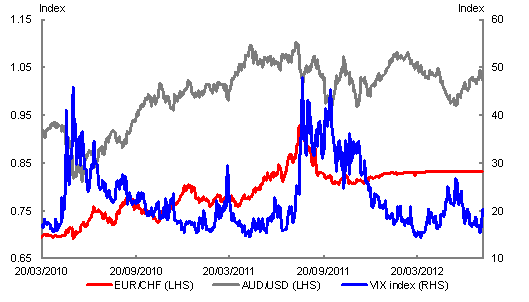
Source: Bloomberg.
One way to demonstrate this property is to look at the relationship between the franc and measures of perceived financial market risk aversion (Chart 6). The VIX volatility index, which reflects the markets expectations of volatility in the S&P 500 index over the next 30 days, is one popular measure of risk aversion. The negative correlation between the VIX volatility index and the franc shows that when risk aversion rises, the franc tends to appreciate.
Empirical studies also support the view that the Swiss franc is a safe-haven currency. Ranaldo and Söderlind (2010) used a factor model to capture linear and non-linear linkages between currencies, stock and bond markets and proxies for market volatility and liquidity.
They found that the Swiss franc tends to appreciate against the USD when US stock prices decrease and US bond prices and foreign exchange market volatility increase.
Chart 6: Inflation and central bank policy rates
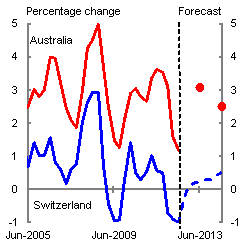
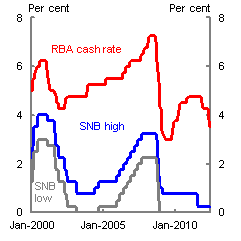
Source: SNB, ABS cat. no. 6401 and Treasury.
Source: RBA and Ecowin.
The structures of the Australian and Swiss economies are also quite different. The Swiss economy is more trade exposed, with trade (exports plus imports) as a share of GDP equal to around 90 per cent, compared to 40 per cent in Australia. Manufacturing, which is highly trade exposed, is also a much larger proportion of the Swiss economy, around 20 per cent, compared to Australia, around 8 per cent. The structure of the Swiss economy tends to exacerbate the procyclical impact of the franc on the Swiss economy.
In addition, the Swiss economy conducts around 70 per cent of its trade with the struggling economies of the European Union (EU), whereas Australia’s main trading partners in Asia have generally continued to perform strongly recently.
The recent performance of the Swiss economy has also been quite different to that of Australia. In particular, Switzerland is currently going through a period of deflation, which began in late 2011 and is expected to continue through 2012 (Chart 7).11
At the same time, the Swiss policy interest rate has recently hit the zero lower bound, the point at which traditional monetary policy has reached its limit in terms of stimulating the economy.
Despite these deflationary pressures, safe haven flows have continued to put upward pressure on the franc. To counter this, the SNB intervened and set a minimum exchange rate of 1.20 Swiss francs per euro on 6 September 2011.12
The SNB has committed to purchasing unlimited quantities of foreign currency in order to hold the franc below the cap. Importantly, the SNB is now engaging in unsterilized foreign currency intervention, as it is not offsetting the effects of its foreign currency purchases on the monetary base (Chart 8). Unsterilized interventions are much more effective in influencing the exchange rate than sterilised interventions (Appendix A).
Chart 7: Swiss base money and foreign currency investments
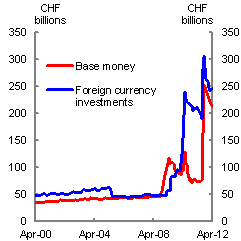
Source: SNB and IMF.
Given that the policy rate is already at the zero lower bound, the increases in the monetary base that have occurred as a result of the intervention are having no effect on the SNB’s target interest rate (as it cannot fall below zero). The SNB is effectively engaging in a form of unconventional monetary policy in pursuit of its price stability mandate. Under the circumstances faced by the Swiss economy, many commentators, including the IMF, have endorsed the SNB’s action.13
In spite of the stark differences between Australia and Switzerland, some commentators have recently called for the RBA to follow the path of the SNB and lower the value of the AUD. However, the Australian economy:
- does not have a highly procyclical currency;
- does not have Switzerland’s problem of dependence on economically weak trading partners;
- does not have a problem with deflation; and
- does not have interest rates at the zero lower bound (and therefore cannot undertake unsterilized intervention without pushing down the cash rate, which would be inconsistent with the RBA’s inflation targeting mandate).
As the current challenges faced by the Australian economy are quite different to those faced by the Swiss, there is no coherent reason for the RBA to follow the lead of the SNB and lower the value of the AUD. While the SNB’s approach is consistent with its mandate given its circumstances, adopting the same approach here would raise fundamental conflicts with the RBA’s inflation target.
Conclusion
Over the past decade the AUD has appreciated substantially, primarily as a result of a dramatic rise in the terms of trade. An additional factor boosting the AUD since the GFC has been Australia’s relatively strong economic performance, which has resulted in interest rates in Australia close to normal levels, while those in most advanced economies are close to zero. The currency is also being supported by Australia’s standing as a low risk country in a world where the number of such countries is dwindling.
However, while the AUD is now well above its post-float average, it appears to be at a level consistent with what might be expected, given the changes in its fundamental determinants.
Ultimately, the value of the AUD must be judged according to whether it is consistent with macroeconomic stability. If the high exchange rate is judged to be inconsistent with keeping the economy close to non-inflationary full employment, we could expect that monetary policy would be eased in response, putting downward pressure on the AUD. Hence, the remedy for such a problem is available within the existing policy framework.
As such, calls for Australia to shift away from its long-standing policy approach and take action directed at lowering the value of the AUD are misplaced. Rather than helping the economy, the available options are likely to be either ineffective or result in greater macroeconomic instability. The combination of flexible inflation-targeting monetary policy and a floating exchange rate has served Australia well in delivering macroeconomic stability through a range of shocks over the past two decades. There is no coherent reason to believe that it is inappropriate for current economic circumstances.
Appendix A: Foreign exchange market intervention
The economic literature suggests that sterilised intervention may affect the exchange rate through two channels: a signalling channel and a portfolio balance channel (for example, see Sarno and Taylor 2001 and Dominguez and Frankel 1993).
The signalling channel operates through intervention being interpreted as a signal of the central bank’s view on the appropriate level of the exchange rate, and hence of the likelihood that it may take monetary policy action in support of this view. As such, the signalling channel is ultimately not independent of monetary policy.
The portfolio balance channel operates through the effect of intervention on the composition of inv
estors’ portfolios, assuming domestic and foreign securities are not viewed as perfect substitutes. When the central bank purchases foreign assets and sterilises by selling domestic securities, other investors must hold more domestic securities (and fewer foreign securities). If domestic and foreign assets were perfect substitutes this would have no effect: the additional domestic securities would be absorbed without any change in asset prices. Demand for Australian dollars from foreign investors’ acquisition of these securities would exactly offset demand for foreign currency from the central bank’s purchase of foreign securities.
Investors are more likely to view domestic and foreign assets as somewhat imperfect substitutes because they prefer to hold a balanced portfolio to diversify country-specific risks. This means they will demand a higher risk premium to increase the portfolio share of a country’s securities, requiring the domestic currency to fall in order to lower the price of these securities relative to foreign securities.
The effects of sterilised intervention through this channel depend on the degree of substitutability between domestic and foreign securities, and the size of central bank purchases relative to outstanding stocks of these securities. Results from empirical studies on the effectiveness of sterilised intervention are mixed. To the extent that intervention is effective, this is generally attributed to the signalling channel, as interventions are invariably too small to have significant effects on portfolio balance.
This point is illustrated by the following figures. According to the IMF’s Global Financial Stability Report, the global stock of debt and equity securities at the end of 2010 was worth around US $150 trillion. The ABS Financial Accounts indicate that the stock of securities issued by Australian entities was worth around $4 trillion: hence, Australian securities comprised about 2.7 per cent of the global portfolio. Increasing this portfolio share by a tiny 0.1 of a percentage point would therefore require a very large foreign asset acquisition of $150 billion (more than 10 per cent of current Australian GDP).
Foreign asset acquisition by governments affects the exchange rate through portfolio balance effects in the same way as sterilised intervention by the central bank. It cannot, however, work through a signalling channel as monetary policy is set independently by the RBA.
If budget surpluses are used to acquire foreign securities, rather than repaying existing government debt or acquiring domestic securities, this means that other investors must hold more domestic securities than otherwise. As with sterilised intervention, impacts on the exchange rate depend on the asset acquisition being large enough to have a significant effect on investors’ portfolio balance and, thereby, the risk premium on domestic securities.
References
Balassa, B, 1964, ‘The purchasing power parity doctrine: A reappraisal’, The Journal of Political Economy, vol 72, no. 6, pp 584-596.
Dominguez, K.M and Frankel, J.A, 1993, ‘Does Foreign-exchange intervention matter? The portfolio effect’, The American Economic Review, vol 83, no. 5, pp 1356-1369
Ellis, L, 2001,‘Measuring the real exchange rate’, RBA Bulletin, November.
Garton, P, 2012, ‘Sovereign wealth funds and the exchange rate: comparing resource booms in Australia’, Chile and Norway, Economic Roundup Issue 2.
Garton, P and Gruen, D 2012, ‘The Role of Sovereign Wealth Funds in Managing Resource Booms: a Comparison of Australia and Norway’, address by second author to the Third Annual Asia Central Bank and Sovereign Wealth Fund Conference, 23 February
Gruen, D, 2011, ‘The macroeconomic and structural implications of a once-in-a-lifetime boom in the terms of trade boom’, Address to the Australian Business Economists Annual Conference.
Gruen, D and Wilkinson, J, 1994, ‘Australia’s Real exchange rate — Is it explained by the terms of trade or by real interest differentials?’, The Economic Record, vol 70, no. 209, pp 204-19.
Henry, O.T and Olekalns, N, 2002, ‘Does the Australian dollar real exchange rate display mean reversion’, Journal of International Money and Finance, vol 21, no. 5, pp 651-666.
IMF, 2006, ‘Methodology for CGER Exchange Rate Assessments’, research department, International Monetary Fund, November 2006.
IMF 2012, ‘2012 Article IV Consultation — Concluding Statement’, viewed 3 May,
http://www.imf.org/external/np/ms/2012/032012.htm.
Ranaldo, A and Söderlind, P, 2010, ‘Safe haven currencies’, Review of Finance, vol 14, no. 3, pp 385-407.
RBA 2002, ‘Developments in the Trade-Weighted Index’, RBA Bulletin, October.
RBA 2011, ‘Foreign exchange intervention’, RBA Bulletin, December quarter.
Samuelson, P.A., 1964, ‘Theoretical notes on the trade problems’, Review of Economics and Statistics, vol 46, no. 2, pp 145-164.
Sarno, L and Taylor, M.P, 2001, ‘Official intervention in the foreign exchange market: is it effective and, if so, how does it work?’, Journal of Economic Literature, vol 39, no. 3, pp 839-868.
Swiss National Bank, 2011, ‘Swiss National Bank sets minimum exchange rate at CHF 1.20 per euro’, media release, viewed 4 May,
http://www.snb.ch/en/mmr/reference/pre_20110906/source/pre_20110906.en.pdf.
Swiss National Bank, 2012, ‘Quarterly Bulletin’, March, Volume 30.
Wren-Lewis, S 2003, ‘Estimates of equilibrium exchange rates for sterling against the Euro’, HM Treasury.
1 The authors are from Macroeconomic Policy Division, the Australian Treasury. This article has benefited from comments and suggestions provided by James Kelly, Shane Johnson and David Gruen. The views in this article are those of the authors and not necessarily those of the Australian Treasury.
2 Unless otherwise stated, impacts on the exchange rate are discussed on the assumption that other things are unchanged, including in the rest of the world. A shock with identical effects on Australia and our trading partners would not affect the exchange rate. Hence, the exchange rate only helps adjustment to shocks that are ‘asymmetric’.
3 The role of the exchange rate in equilibrium is discussed at greater length in Garton (2012).
4 The rise in commodity prices could itself contribute to real appreciation if the relevant prices affect a larger share of domestic expenditures than foreign expenditures. This effect is unlikely to be significant for a CPI-based real exchange rate.
5 This stems from uncertainties over the assumptions on potential output and current account ‘norms’, exchange rate elasticities and projections of future fundamentals, as well as uncertainties affecting reduced form econometric estimation.
6 Absolute PPP assumes that price levels converge over time. A less restrictive variant, known as relative PPP, assumes that rates of price growth converge over time, recognising that t
ransport costs and other factors may create permanent price differences. In both cases, the real exchange rate is assumed to revert to a constant.
7 See, for example, Gruen and Wilkinson (1994) and Henry and Olekalns (2002).
8 The official cash rate set by the RBA depends on the balance between demand and supply for exchange settlement balances held by banks with the RBA. Purchases of foreign exchange by the RBA would increase the supply of these balances and, thereby, depress the cash rate unless offset by matching sales of domestic securities that reduces supply.
9 While the RBA does not take a completely ‘hands off’ approach to the exchange rate, it nowadays intervenes only during periods of market dysfunction (RBA 2011). The last such interventions occurred during the global financial crisis in October-November 2008.
10 The extent to which economic activity is dampened depends on the size of the relevant fiscal multiplier, which is a function of a number of factors, including the degree of spare capacity, and the composition and timing of fiscal consolidation.
11 All Swiss forecasts are taken from the SNB’s March 2012 Bulletin.
See SNB 2011.
13 See IMF 2012.